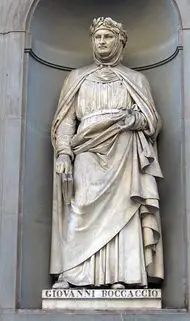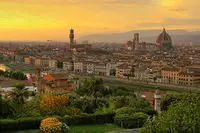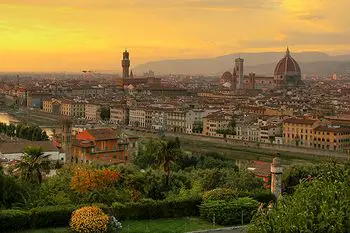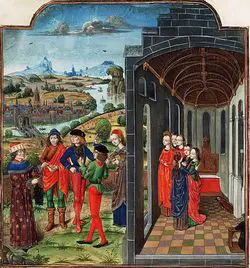Difference between revisions of "How did Boccaccio influence the Renaissance"
| Line 9: | Line 9: | ||
====The life of Giovanni Boccaccio==== | ====The life of Giovanni Boccaccio==== | ||
[[File: Boccaccio 3.jpg|200px|thumb|left|Florence]] | [[File: Boccaccio 3.jpg|200px|thumb|left|Florence]] | ||
| − | The future writer was born in a village outside of the city of Florence, and he was the son of Boccaccio de Chellino, a wealthy merchant and banker, who was employed by the famous Bardi Bank. It appears that Boccaccio was born outside of marriage and he was raised by his father and legitimized. The young boy received an excellent education and was tutored in Latin, and his father also gave him some business training. From an early age, the young Giovanni was determined to be a poet. His father moved to Naples and worked as a financial advisor to the king and Boccaccio was familiar with the Neapolitan Court. The young man was obliged to become an apprentice banker, which he hated, but he was able to meet many writers and scholars.<ref>Bartlett, Kenneth R. The Civilization of the Italian Renaissance. Toronto: D.C. Heath and Company, 1992, p 42-43)</ref> It was about this time that he became interested in the mythology of the Greeks and the Romans. | + | The future writer was born in a village outside of the city of Florence, and he was the son of Boccaccio de Chellino, a wealthy merchant and banker, who was employed by the famous Bardi Bank. It appears that Boccaccio was born outside of marriage and he was raised by his father and legitimized. The young boy received an excellent education and was tutored in Latin, and his father also gave him some business training. From an early age, the young Giovanni was determined to be a poet. His father moved to Naples and worked as a financial advisor to the king and Boccaccio was familiar with the Neapolitan Court. The young man was obliged to become an apprentice banker, which he hated, but he was able to meet many writers and scholars.<ref>Bartlett, Kenneth R. [https://www.amazon.com/gp/product/1442604859/ref=as_li_tl?ie=UTF8&camp=1789&creative=9325&creativeASIN=1442604859&linkCode=as2&tag=dailyh0c-20&linkId=c3d374ea225865ed2995e8921320d0f6 The Civilization of the Italian Renaissance.] Toronto: D.C. Heath and Company, 1992, p 42-43)</ref> It was about this time that he became interested in the mythology of the Greeks and the Romans. |
The young man would regularly attend the Royal Court, and he fell in love with the young daughter of the king, who inspired some of his later works, but his passion was unrequited. Boccaccio’s first efforts were in poetry, and he was much influenced by the Sicilian School.<ref>, Bartlett, p 42</ref> He wrote a long poem, Il Filostrato, and Teseida, which represented his emotional turmoil caused by his unrequited love for the King’s daughter. In 1340 the Bardi Bank collapsed, and this creates a European financial crisis, which forced Boccaccio to return to Florence, leaving his beloved in Naples. It was at this time that he grew as a writer and wrote a traditional medieval style Romance in verse, In the Elegy of Lady Fiammetta, which has some of his most beautiful poetry. | The young man would regularly attend the Royal Court, and he fell in love with the young daughter of the king, who inspired some of his later works, but his passion was unrequited. Boccaccio’s first efforts were in poetry, and he was much influenced by the Sicilian School.<ref>, Bartlett, p 42</ref> He wrote a long poem, Il Filostrato, and Teseida, which represented his emotional turmoil caused by his unrequited love for the King’s daughter. In 1340 the Bardi Bank collapsed, and this creates a European financial crisis, which forced Boccaccio to return to Florence, leaving his beloved in Naples. It was at this time that he grew as a writer and wrote a traditional medieval style Romance in verse, In the Elegy of Lady Fiammetta, which has some of his most beautiful poetry. | ||
| − | The young writer traveled throughout Italy at this time, and he appears to escape the Black Death unscathed (1347-1350). The plague killed up to one-third of the population of Italy and the devastation it caused, deeply impacted Boccaccio’s writings. The Black Death was directly the inspiration for his most celebrated work the Decameron, which was written between 1348-1353.<ref> Mc William, G.H.: 1995, Introduction to The Decameron by Giovanni Boccaccio, Penguin Classics, Suffolk England, 1995), p 5</ref> This is a large prose work, and it is a collection of short stories or Nouvelles. It was an instant sensation and has remained so to this day. Boccaccio came to regret his masterpiece, and after completing it, he seemed to have experienced some form of crisis. | + | The young writer traveled throughout Italy at this time, and he appears to escape the Black Death unscathed (1347-1350). The plague killed up to one-third of the population of Italy and the devastation it caused, deeply impacted Boccaccio’s writings. The Black Death was directly the inspiration for his most celebrated work the [https://www.amazon.com/gp/product/0140449302/ref=as_li_tl?ie=UTF8&camp=1789&creative=9325&creativeASIN=0140449302&linkCode=as2&tag=dailyh0c-20&linkId=c9aa7bd74453a31a3ad010c425b948eb Decameron], which was written between 1348-1353.<ref> Mc William, G.H.: 1995, Introduction to The Decameron by Giovanni Boccaccio, Penguin Classics, Suffolk England, 1995), p 5</ref> This is a large prose work, and it is a collection of short stories or Nouvelles. It was an instant sensation and has remained so to this day. Boccaccio came to regret his masterpiece, and after completing it, he seemed to have experienced some form of crisis. |
In the 1350s, he met Petrarch and the two men became friends’ and each influenced the works of the other. In the 1350s Boccaccio wrote the biography of Dante and went on to write a collection of portraits <i>On Famous Women and On Famous Men</i>, which was very popular. He also wrote a work on classical mythology, and this is considered to be one of the first studies of myth ever produced. In 1362 during a religious crisis, he met a monk who told him to abandon literature and to burn his extensive library, for the sake of his soul.<ref>McWilliam, p 4</ref> | In the 1350s, he met Petrarch and the two men became friends’ and each influenced the works of the other. In the 1350s Boccaccio wrote the biography of Dante and went on to write a collection of portraits <i>On Famous Women and On Famous Men</i>, which was very popular. He also wrote a work on classical mythology, and this is considered to be one of the first studies of myth ever produced. In 1362 during a religious crisis, he met a monk who told him to abandon literature and to burn his extensive library, for the sake of his soul.<ref>McWilliam, p 4</ref> | ||
Revision as of 21:26, 8 June 2019
The Renaissance was one of the most important periods in the history of the western world. This era saw the development of the modern conception of the individual, the emergence of humanism and new forms of cultural expression, all of which influence us to this day. There are many important figures in this era which lasted roughly two centuries (1320-1527 AD), who contributed to the Renaissance and the revival of European culture.
These included great artists such as Michelangelo and Leonardo and great writers such as Petrarch, Dante, and Machiavelli. One writer who made a dramatic contribution to the Renaissance was Giovanni Boccaccio (1313–1375), although his contribution is often neglected. This article argues that Boccaccio was an important figure in the development of Humanism, the Italian language and the development of modern literature.
The life of Giovanni Boccaccio
The future writer was born in a village outside of the city of Florence, and he was the son of Boccaccio de Chellino, a wealthy merchant and banker, who was employed by the famous Bardi Bank. It appears that Boccaccio was born outside of marriage and he was raised by his father and legitimized. The young boy received an excellent education and was tutored in Latin, and his father also gave him some business training. From an early age, the young Giovanni was determined to be a poet. His father moved to Naples and worked as a financial advisor to the king and Boccaccio was familiar with the Neapolitan Court. The young man was obliged to become an apprentice banker, which he hated, but he was able to meet many writers and scholars.[1] It was about this time that he became interested in the mythology of the Greeks and the Romans.
The young man would regularly attend the Royal Court, and he fell in love with the young daughter of the king, who inspired some of his later works, but his passion was unrequited. Boccaccio’s first efforts were in poetry, and he was much influenced by the Sicilian School.[2] He wrote a long poem, Il Filostrato, and Teseida, which represented his emotional turmoil caused by his unrequited love for the King’s daughter. In 1340 the Bardi Bank collapsed, and this creates a European financial crisis, which forced Boccaccio to return to Florence, leaving his beloved in Naples. It was at this time that he grew as a writer and wrote a traditional medieval style Romance in verse, In the Elegy of Lady Fiammetta, which has some of his most beautiful poetry.
The young writer traveled throughout Italy at this time, and he appears to escape the Black Death unscathed (1347-1350). The plague killed up to one-third of the population of Italy and the devastation it caused, deeply impacted Boccaccio’s writings. The Black Death was directly the inspiration for his most celebrated work the Decameron, which was written between 1348-1353.[3] This is a large prose work, and it is a collection of short stories or Nouvelles. It was an instant sensation and has remained so to this day. Boccaccio came to regret his masterpiece, and after completing it, he seemed to have experienced some form of crisis.
In the 1350s, he met Petrarch and the two men became friends’ and each influenced the works of the other. In the 1350s Boccaccio wrote the biography of Dante and went on to write a collection of portraits On Famous Women and On Famous Men, which was very popular. He also wrote a work on classical mythology, and this is considered to be one of the first studies of myth ever produced. In 1362 during a religious crisis, he met a monk who told him to abandon literature and to burn his extensive library, for the sake of his soul.[4]
Thankfully, Petrarch intervened and persuaded Boccaccio to follow his vocation as a writer and scholar. His native Florence recognized his talents, and he was appointed as a public lecturer on the works of the great Dante. He also because of the influence of his great friend Petrarch, became a diplomat and he was engaged on diplomatic missions throughout Europe. As he grew old, he returned to his native Tuscany and lived in the village of Certaldo, until his death in 1375.
Boccaccio and the birth of the Novel
Despite writing a great deal of poetry, Boccaccio is best known for his prose, and he is acknowledged to be one of the masters of Italian prose. The Florentine was one of the founders of the modern novel, and his most famous work is the Decameron. This work begins with a vivid description of the Black Death and provides one of history’s most terrifying accounts of societal breakdown.[5]
Boccaccio then introduces to the reader to a company of young people who fled the plague in the city to the safety of the countryside. The novel consists of 100 tales that are told by seven young women and three young men. The tales, often love stories, range from the romantic to the erotic. The Decameron was not just a collection of love stories; they provide an overview of the human condition. The characters in the story came from all classes of the Early Renaissance, and many feature nuns, priests and monks.[6]
The stories are all based on folk tales from Italy, France, and as far away as India, but skilfully adapted by the Florentine. All of the stories are in Italian, and they are all very realistic, and the characters behave in a very natural way. This is one of the reasons why the Decameron is still read and admired to this day as it delightful captures the range of human emotions, strengths, and weaknesses. The tales in the Decameron had many admirers and influenced numerous writers throughout the Renaissance in Italy and beyond. The work was the inspiration for Chaucer’s Canterbury Tales, one of the first great works in the canon of English literature.[7] Many of the tales in the 14th-century work were adapted by dramatists of the stature of Shakespeare, Lope De Vega, and Moliere.
Boccaccio’s work was a shift away from Medieval Romances to literary realism. He demonstrated that prose could capture the complexity of humans and their situations, and while poetry remained the dominant mode of literary expression, after the Decameron, literary prose became more popular and widely accepted. The second extraordinary work of Boccaccio is The Elegy of Lady Fiammetta (1345-1347), and this is regarded as the world’s first psychological novel. This work is in the form of a monologue by a young woman narrating her tragic love for a young merchant. Boccaccio’s work was unlike anything else written before, and its psychological realism was a radical departure from medieval literature where characters were stereotypes and not individuals.
Boccaccio inspired many writers to abandon allegory, so typical of the Middle Ages and adopt a realist style of writing.[8] The Florentine was also one of the first biographers and his work on the Life of Dante is one of the first literary biographies. His potted accounts of the lives of famous people also decisively shaped the Renaissance tradition of biography, for example, Vasari’s Lives of the Artists. Boccaccio's impact on literature in Europe cannot be overstated. [9]
Boccaccio and poetry
Today the poetry of Boccaccio is only read by academics and his fame as a poet has long since been eclipsed by his works in prose. However, he was a fine poet and he decidedly shaped the direction of Renaissance poetry in both Italy and elsewhere. He helped to popularise many rhymes and verse forms especially the Octavo stanzas. Moreover, it appears that he introduced Petrarch to the works of the Sicilian School which had developed innovative stanza forms. Many believe that this inspired Petrarch to develop his own form of the sonnet.[10] Boccaccio wrote many long narrative poems,’ and this inspired many poets throughout Europe, including Chaucer. His long poems such as the Il Filostrato had many imitators, and indeed this work was the basis for Shakespeare’s tragedy Troilus and Cressida.
The poet’s works are often categorized as belonging to the ‘Courtly Love’ tradition and his verse popularized this form of self-expression, throughout the European realms. Boccaccio’s poetry was very much focused on the personal and the emotional lives of the individual and their ambitions, hopes, and sorrows.[11] This was something that inspired many to adopt a more personal style of verse which had a great impact on European culture from the 14th century to the present.
Influence on Humanism
Boccaccio was very much interested in the classical past and can be considered to be one of the great mediators between the classical world and Renaissance Italy. His encyclopedia on classical myths did much to generate interest in Ancient history and culture and persuaded many to study Greek-Roman civilization. Boccaccio was like his friend Petrarch fascinated by the classical past, and he popularized the works of Homer in Florence, and this persuaded many to study the works of the poet who sang of the destruction of Troy and the adventures of Odysseus. Boccaccio was one of the first Italians who celebrated the Greeks and their culture, especially in his role as a public lecturer.
Boccaccio was a deeply religious man, but he saw value in this life and believed that earthly pleasure was not inherently sinful. There is a real delight in nature and people in the works on the writer, and he stressed that everyone was an individual.[12] In his works, his characters are struggling with circumstances and using their reason and foresight to improve their lot in life. In his main work, he shows young people enjoying and celebrating life even though the Black Death is raging all around them.[13] The Decameron was influential in promoting the humanistic worldview in the Renaissance.
Vernacular literature

Boccaccio was determined to make Italian a respected literary language. Until the start of the 14th century, Italian was not considered to be a vehicle for literary expression. Latin was the language of the literary elite and the vernacular languages were not rated highly. Beginning with Dante the use of the vernacular became more accepted in poetry. What Dante did for poetry, Boccaccio did for prose. He used his native Tuscan and was able to make it capable of great descriptive power and expression. He sought to create an Italian that was as concise as Latin and his prose does have this quality.
The quality of the prose, its precision, and elegance demonstrated that Italian was the equal of Latin. Boccaccio’s Decameron, in particular, was read around Europe and it inspired other authors to write in their native language and shun Latin. The author contributed to one of the most significant changes in Europe wrought by the Renaissance and that was the adoption of the vernacular languages for literary expression.[14]
Conclusion
Boccaccio was one of the three great writers of the early Renaissance who decisively shaped its direction. He along with Dante and Petrarch laid the foundations for the literature of this period not only in Italy but also throughout Europe. Boccaccio was a great writer and he helped to elevate prose and made it a vehicle for literary works. He was also critical in the development of the novel and he shifted literature away from allegory and romance to a more realistic approach. His emphasis on the psychology of his characters and by describing individuals in social settings he changed the direction of literature and this is evident in the prose and drama of the period. While best known as a prose writer he helped to develop new techniques for poetic expression and his narrative poems found many imitators.
Like many other intellectuals of the time, he did not believe that this life was a vale of tears but had meaning and joy, as evident in the characters and the stories of the Decameron. The author was critical in the development of Italian as a literary language and this, in turn, influenced many throughout Europe to write in their mother tongue and this ultimately led to the establishment of national literature.
Further Reading
Lewis, Clive Staples. The discarded image: An introduction to medieval and renaissance literature (Cambridge, Cambridge University Press, 1994).
Kallendorf, Craig. "The rhetorical criticism of literature in early Italian humanism from Boccaccio to Landino." Rhetorica 1, no. 2 (1983): 33-59.
Mazzotta, Giuseppe. The World at Play in Boccaccio's Decameron. (Princeton University Press, 2014)- ↑ Bartlett, Kenneth R. The Civilization of the Italian Renaissance. Toronto: D.C. Heath and Company, 1992, p 42-43)
- ↑ , Bartlett, p 42
- ↑ Mc William, G.H.: 1995, Introduction to The Decameron by Giovanni Boccaccio, Penguin Classics, Suffolk England, 1995), p 5
- ↑ McWilliam, p 4
- ↑ Bowsky, William M. The Black Death: A Turning Point in History (Holt Rinehart & Winston, New York, 1971), p. 13
- ↑ McWilliam, p 6
- ↑ Herbert G. Boccaccio in England: From Chaucer to Tennyson (London, A&C Black, 2014), p 13
- ↑ Burckhardt, Jacob, The Civilization of the Renaissance in Italy (London, Penguin Books, 1987), p 67
- ↑ McWilliams, p 4
- ↑ McWilliams, p 7
- ↑ Burckhardt, p. 113
- ↑ Burckhardt, p. 19
- ↑ Steel, David. "Plague writing: from Boccaccio to Camus." Journal of European Studies 11, no. 42 (1981): 88-110
- ↑ Brotton, J., The Renaissance: A Very Short Introduction (Oxford, OUP, 2006), p 19



